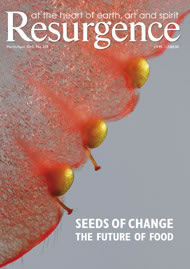Another piece of the jigsaw puzzle of ‘the vanishing face of Gaia’ is admirably addressed in Alison Benjamin and Brian McCallum’s erudite and well-researched picture of the honeybee over the centuries. From the start, it introduces some stark facts about the threats to their survival, including how they are being inducted into industrialised agriculture, and the response of governments and big business.
The scale of ‘migratory beekeeping’ in California is astonishing: 60 million almond trees, spread over 600,000 acres, to be pollinated by 40 billion trucked-in bees, carried out in just twenty-two days, in February every year, earning US$15 billion in the USA overall, and US$60 billion worldwide. This sets the scene for the main theme of the book, which is the sudden disappearance of whole colonies of honeybees (a phenomenon that has occurred in many different countries) and why this is taking place.
As a novice to the theme of bee-keeping, I found it a pleasure not only to build more knowledge effortlessly throughout but also to learn how bees have been viewed down through history and how different countries have reacted to the various theories of why whole colonies suddenly die or simply disappear: how individual bee-keepers react, how independent scientists react, how big business responds, and how various governments decide either to contribute funds or delay passing restrictive laws on pesticides.
Honeybees, of course, not only make honey, but in that process pollinate flowers and vegetables. Benjamin and McCallum explain that 80% of plant pollen is spread by bees – the remainder is served by the wind. The authors also go through the bees’ life cycle and yearly cycle; important for understanding the complexities of the threats that currently assail them.
A description of the various types of honeybee and how they are being interbred in the USA to create so-called superbees is also relevant to why they are suddenly dying. Although the European black bee, for example, is a species which has been shown to develop resistance to the varroa mite – the main threat to the honeybee – it is not being introduced to the USA as it is “a lot more defensive” (a euphemism for it stings more readily and so might lead to lawsuits). And this lack of diversity may, in fact, be a major reason why the bees are dying off.
Another commendable aspect of this book is the authors’ fairness to all parties: whenever one suspect is named as the reason for CCD (colony collapse disorder), another expert explains their reasons for doubting the evidence.
Apart from the varroa mite, the main suspects are pesticides (in particular neonicotinoids), GM crops, and the stress factors involved in trucking bees (in the USA) all over the country to ‘service’ the fruit trees. Although pesticide companies and governments are starting to respond to the scale of the threat, bans on pesticides do not usually last long. Plus, chemicals that are harmless to mature bees can be fatal for the young larvae in the hive.
No-one wants to take the blame and there are no quick fixes but the usual culprits appear responsible: the drive for instant solutions and quick profits, and no time for care. Given that one UK government minister has said that in ten years’ time there may be no honeybees, and that without them we would have no apples, almonds, cotton, citrus, soya beans, onions, broccoli or carrots, as well as many other foods, another huge warning bell has sounded. Honeybees have been compared to ‘the canary in the coal mine’, giving notice of imminent danger in the environment. Ignorance, unsustainable agricultural practices and the continued dangerous use of chemicals are seen by the authors as the prime causes for the bees’ demise.
So, can we change this? Well, recent research shows a bees’ immune system is weakened when they have fewer wild plants to gather pollen from. So, by rejuvenating wild flowers in hedgerows and other spaces, bees could rebuild their resistance. It is up to us.







